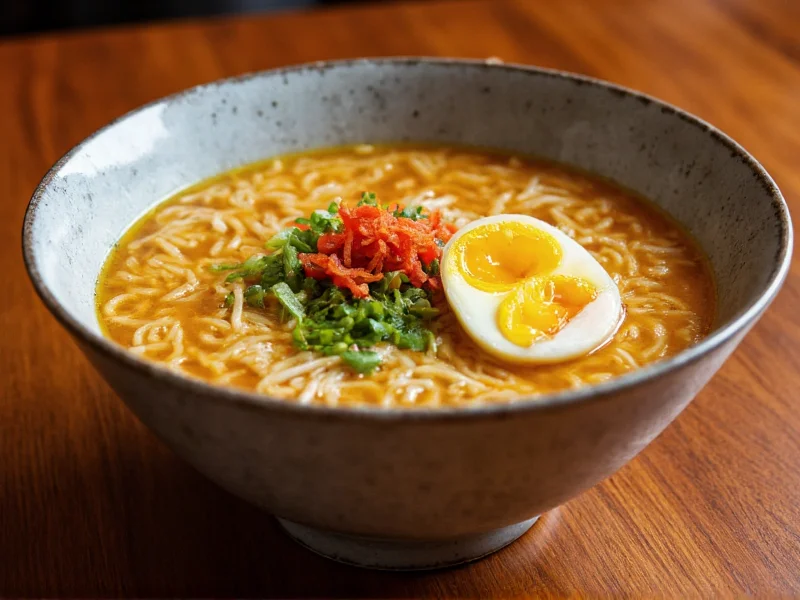When people ask is ramen soup, they're often confused about whether ramen refers to just the broth or the complete dish. This misunderstanding stems from the popularity of instant ramen products that use 'ramen' to describe the entire packaged meal. In traditional Japanese cuisine, ramen describes the complete dish, while the liquid component is specifically called the broth or soup.
Breaking Down Ramen Components
Understanding what constitutes authentic ramen requires examining its four fundamental elements:
| Component | Description | Preparation Time |
|---|---|---|
| Broth (Soup) | Base liquid made from simmered bones, meat, and aromatics | 4-48 hours |
| Tare | Seasoning concentrate (shoyu, miso, shio, or tonkotsu) | Pre-made |
| Noodles | Wheat-based alkaline noodles with specific texture | 30-60 minutes |
| Toppings | Chashu pork, egg, nori, vegetables, etc. | Varies |
Common Misconceptions About Ramen Soup
Many people confuse ramen soup with instant ramen products. What is ramen soup made of in authentic preparation differs significantly from the powdered flavor packets found in grocery stores. Traditional ramen broth requires careful preparation, while instant ramen soup base contains preservatives and artificial flavors.
The question is ramen soup healthy depends entirely on preparation method. Restaurant-style ramen soup made from scratch with quality ingredients provides protein and nutrients, while instant ramen soup often contains excessive sodium and MSG. Understanding the difference between ramen and ramen soup helps clarify nutritional considerations.
Types of Authentic Ramen Broth
Japanese cuisine features several distinct ramen soup varieties, each defined by its base ingredients and preparation:
- Shoyu - Soy sauce-based broth, typically made with chicken or vegetable stock
- Miso - Fermented soybean paste broth, often with a rich, complex flavor
- Tonkotsu - Pork bone broth simmered for hours until creamy and opaque
- Shio - Salt-based broth, usually lighter and clearer than other varieties
Each regional variation of ramen in Japan features distinctive soup characteristics. For example, Hakata ramen from Fukuoka specializes in rich tonkotsu broth, while Sapporo ramen often features miso-based soup with hearty toppings suitable for cold climates.
Traditional Ramen Soup Preparation
Authentic ramen soup preparation follows meticulous methods that differ significantly from instant ramen soup preparation. Professional ramen chefs often dedicate days to creating the perfect broth. The process typically involves:
- Blanching bones to remove impurities
- Simmering bones and meat for extended periods (4-48 hours)
- Adding aromatics like garlic, ginger, and scallions
- Straining the broth to achieve clarity
- Preparing tare (seasoning base) separately
- Combining broth with tare just before serving
This careful process creates the complex flavors that define quality ramen soup. When asking what is ramen soup made of in traditional preparation, the answer involves patience and attention to detail rather than quick fixes.
Ramen Soup vs. Instant Ramen
The difference between ramen and ramen soup becomes particularly clear when comparing authentic preparation to instant products. While traditional ramen soup forms just one component of the complete dish, instant ramen packages often market the entire product as 'ramen soup.'
Understanding ramen soup vs instant ramen reveals significant differences:
- Traditional ramen soup contains natural ingredients with complex flavors developed through slow cooking
- Instant ramen soup base relies on powdered flavorings with high sodium content
- Authentic preparation allows customization of broth strength and flavor
- Restaurant ramen soup typically has lower sodium levels than instant varieties
When evaluating is ramen soup healthy, consider that traditional ramen soup made from scratch provides collagen, amino acids, and nutrients from properly simmered bones, while instant versions often contain artificial additives and excessive sodium.
Appreciating Ramen Soup Culture
Ramen's journey from Chinese-inspired street food to Japanese culinary icon demonstrates the importance of the soup component. The broth represents the soul of the dish, with regional variations reflecting local tastes and available ingredients.
Modern ramen culture continues evolving, with chefs experimenting with traditional ramen soup preparation while respecting foundational techniques. Whether enjoying a simple bowl at a local shop or crafting homemade ramen soup, understanding the components enhances appreciation for this beloved dish.
What exactly is ramen soup?
Ramen soup refers specifically to the broth component of the complete ramen dish. It's the liquid base made by simmering bones, meat, and aromatics for hours, forming the foundation upon which the entire dish is built. The soup differs from the complete ramen meal which includes noodles, tare (seasoning), and toppings.
Is ramen soup the same as instant ramen?
No, ramen soup and instant ramen are fundamentally different. Authentic ramen soup is a carefully prepared broth that takes hours to make, while instant ramen refers to a complete packaged product with dried noodles and powdered flavoring. The 'soup' in instant ramen is actually a flavoring powder dissolved in hot water, not a traditionally prepared broth.
What are the main types of ramen soup?
The four primary types of ramen soup are shoyu (soy sauce-based), miso (fermented soybean paste), tonkotsu (pork bone broth), and shio (salt-based). Each type has distinctive flavor profiles and regional variations throughout Japan, with some areas developing unique hybrid styles that combine elements of multiple broth types.
How is traditional ramen soup made?
Traditional ramen soup preparation involves blanching bones to remove impurities, then simmering them for 4-48 hours with meat and aromatics. Chefs carefully monitor the broth to achieve the desired clarity and flavor. The process concludes with straining the liquid and combining it with tare (seasoning base) just before serving with noodles and toppings.
Is ramen soup healthy compared to instant versions?
Authentic ramen soup made from scratch can be part of a balanced diet, providing protein, collagen, and nutrients from properly simmered bones. It typically contains less sodium than instant ramen soup packets, which often include artificial flavors, preservatives, and excessive sodium. The healthiness depends on preparation methods and portion sizes.











 浙公网安备
33010002000092号
浙公网安备
33010002000092号 浙B2-20120091-4
浙B2-20120091-4